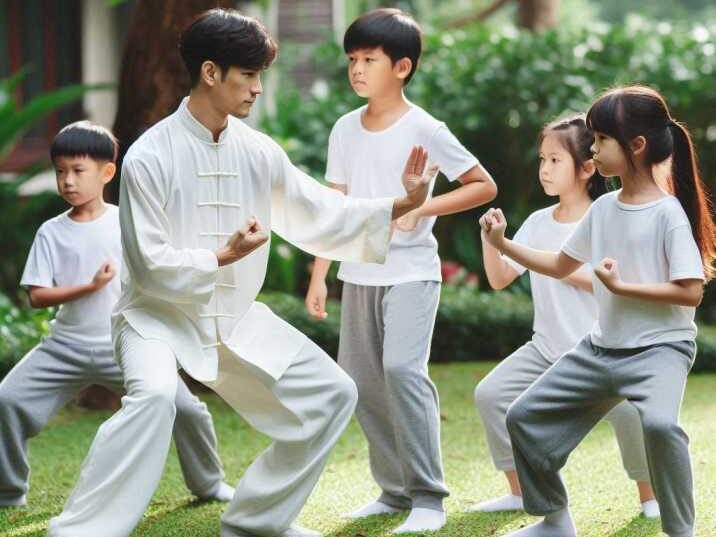Introduction
Table of Contents
Tai chi is a gentle form of exercise that improves your body, mind, and spirit. Often called “moving meditation,” it’s perfect for people of all ages to practice at home. Not only does tai chi boost physical health, but it also helps you stay focused, calm, and balanced in life. In this guide, you’ll discover tai chi exercises you can easily try at home and how they can make you stronger and more focused for school or other activities.

Table of Contents
- What is Tai Chi?
- Benefits of Practicing Tai Chi at Home
- Basic Tai Chi Principles
- How to Get Started with Tai Chi Exercises at Home
- 5 Simple Tai Chi Moves for Beginners
- Tips for Practicing Tai Chi at Home
- FAQs About Tai Chi
What is Tai Chi?
Tai chi is an ancient Chinese martial art that combines slow, controlled movements with deep breathing. It’s designed to improve balance, strength, and flexibility while reducing stress. The name “tai chi” means “supreme ultimate,” reflecting its purpose of achieving harmony between the body and mind.
Benefits of Practicing Tai Chi at Home
1. Improves Focus and Concentration
Practicing Tai chi requires you to be present in every movement, which enhances your ability to concentrate. The discipline needed to master the slow and deliberate motions translates to improved focus in other areas of life, like schoolwork or hobbies. Over time, this practice sharpens mental clarity and boosts memory. By staying mindful during tai chi, you train your brain to be more attentive and less easily distracted.
2. Strengthens Your Body
Unlike intense workouts, tai chi uses slow, fluid movements to engage and strengthen muscles. These motions target your core, legs, and arms, helping you build endurance without straining your joints. Regular practice also improves coordination, making daily activities easier. As a low-impact exercise, tai chi suits all fitness levels while promoting steady physical development.
3. Relieves Stress
The deep breathing and meditative movements of tai chi help reduce stress and anxiety. Focusing on the flow of the movements calms your mind and relaxes your body. This creates a sense of inner peace, even on the busiest days. Practicing tai chi at home allows you to enjoy this stress relief in a familiar and comfortable environment, making it an excellent tool for emotional well-being.
4. Enhances Balance and Flexibility
Tai chi emphasizes controlled weight shifts and steady posture, which naturally improve balance. These movements also gently stretch your muscles, increasing flexibility over time. By practicing regularly, you strengthen the muscles that stabilize your body, reducing the risk of falls or injuries. Tai chi’s focus on fluidity also helps you move more gracefully in everyday life.
5. Accessible to All
One of the greatest benefits of tai chi is its simplicity. You don’t need special equipment, a gym membership, or even a large space. All you need is a small, quiet area and comfortable clothing. The gentle nature of tai chi makes it ideal for all ages and fitness levels, ensuring everyone can benefit from this versatile practice.
Basic Tai Chi Principles
1. Mindfulness
Mindfulness is the foundation of tai chi. It involves focusing on the present moment and letting go of distractions. Each movement should be intentional and purposeful, helping you connect with your body. This mindfulness not only improves your tai chi practice but also reduces stress and increases awareness in daily life.
2. Posture
Good posture is essential for tai chi to be effective. Stand tall with your back straight and shoulders relaxed. Avoid slouching or stiffening your body, as tai chi movements should flow naturally. Proper alignment ensures that energy flows freely through your body, enhancing both balance and flexibility.
3. Breathing
Tai chi incorporates deep, rhythmic breathing to synchronise with movements. Inhale deeply through your nose, allowing your belly to rise, and exhale fully through your mouth. Controlled breathing helps calm your mind, oxygenate your body, and improve your focus during practice.
4. Flow
Practicing Tai chi is all about continuous, flowing motions. Each movement transitions smoothly into the next without pauses. This fluidity helps you stay balanced and coordinated while cultivating a sense of inner harmony. Practicing this flow trains your body and mind to work together seamlessly.
How to Get Started with Tai Chi Exercises at Home
1. Create a Quiet Space
Choose a spot in your home that is free of clutter and distractions. It should have enough room for you to stretch your arms and move freely without bumping into furniture. A peaceful environment helps you focus better and fully immerse yourself in the practice, making each session more effective.
2. Wear Comfortable Clothes
Opt for loose-fitting clothes that allow your body to move freely. Restrictive clothing can hinder your ability to perform tai chi movements properly. Practicing barefoot or wearing soft-soled shoes is ideal for maintaining balance and improving your connection to the ground.
3. Learn from Online Resources or Videos
If you’re a beginner, start by watching tai chi tutorials online. Many videos break down the basic movements step by step, making it easy to follow along. This is a convenient way to learn at your own pace while still benefiting from expert guidance.
4. Start with Warm-Ups
Before diving into tai chi movements, take a few minutes to warm up. Gentle stretches or light exercises can loosen your muscles and prepare your body. Warm-ups help prevent injury and allow you to perform the tai chi movements more effectively.

5 Simple Tai Chi Moves for Beginners
1. Commencing Form
This is the starting point for most tai chi practices. Stand with your feet shoulder-width apart and arms relaxed at your sides. Slowly raise your arms to shoulder height, then gently lower them. Focus on matching your movements to your breath, which will help you feel centered and calm.
2. Wave Hands Like Clouds
Shift your weight to one leg as you move your arms in a circular, waving motion. Imagine your hands moving through clouds. Alternate sides as you shift your weight back and forth. This exercise improves balance, coordination, and mindfulness.
3. Golden Rooster Stands on One Leg
Balance on one foot while lifting the opposite knee. Extend your arms forward to maintain stability. This move strengthens your legs and core while improving balance and focus. Practice alternating sides for a complete workout.
4. Repulse the Monkey
Step backward while pushing your hands forward as if gently warding off an object. Alternate legs with each step. This move improves coordination and helps you stay grounded while teaching you to maintain your balance during transitions.
5. Grasp the Sparrow’s Tail
Combine pushing, pulling, and circling movements with smooth transitions between them. This move emphasizes flow and coordination, making it a great way to practice tai chi’s principles. It also strengthens your arms and core.
Tips for Practicing Tai Chi at Home
1. Practice Daily
Consistency is key to improving your tai chi skills. Even just 10–15 minutes a day can lead to noticeable benefits over time. Making tai chi a daily habit helps you maintain physical and mental well-being.
2. Stay Patient
Mastering tai chi takes time and practice. Focus on learning the basics first and gradually improving your technique. Remember that it’s okay to make mistakes as long as you stay committed to practicing regularly.
3. Focus on Form
The quality of your movements matters more than their speed. Pay attention to maintaining proper posture and alignment throughout each exercise. A solid foundation in form will help you progress safely and effectively in your practice.
Conclusion
Practicing Tai chi is a wonderful way to enhance your physical and mental well-being without leaving the comfort of your home. Its gentle movements, combined with deep breathing, make it perfect for people of all ages. By practicing tai chi exercises at home, you can improve your focus, balance, and flexibility while reducing stress and building inner calm.
The beauty of tai chi lies in its simplicity—you don’t need expensive equipment or a large space. Just a few minutes a day of consistent practice can lead to lasting benefits. Whether you’re a beginner or looking for a peaceful way to stay active, tai chi offers something for everyone.
Start your tai chi journey today, and experience the harmony and strength it can bring to your life!
FAQs About Tai Chi
1. Is tai chi suitable for kids?
Yes, tai chi is great for kids as it improves focus and physical health.
2. Do I need equipment for tai chi?
No, tai chi requires no equipment, making it perfect for at-home practice.
3. How long should a beginner practice?
Start with 10–15 minutes daily and gradually increase the time.
4. Can tai chi help with anxiety?
Yes, tai chi’s deep breathing and flowing movements help reduce stress and promote calmness.
5. What’s the best time to practice tai chi?
Early mornings or evenings are ideal when the mind is calm and focused.


